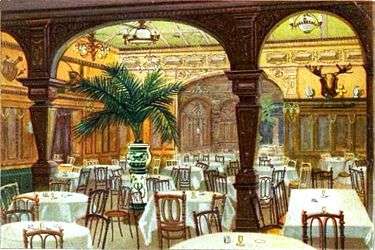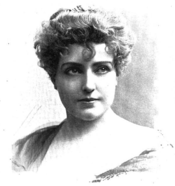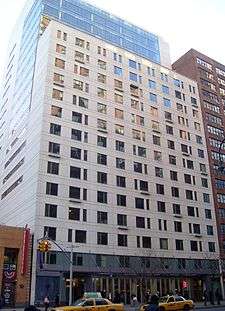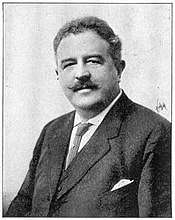Lüchow's
Lüchow's was a restaurant located at 110 East 14th Street at Irving Place in East Village (near Union Square) in Manhattan, New York City, with the property running clear through the block to 13th Street. It was established in 1882[1] – at a time when the surrounding neighborhood was primarily residential[2] – when a German immigrant, August Lüchow, purchased the cafe where he worked as a bartender and waiter.[3] Lüchow's remained in operation at this place for a full century, becoming a favorite establishment for people in the entertainment world, helped by its proximity to the Academy of Music, the city's opera house, as well as Steinway Hall and Tammany Hall, where other entertainment was offered.[2]

Although in the 1930s columnist O. O. McIntyre had written "In a changing world, nothing changes at Lüchow's", eventually even the long-running establishment came to an end,[4] closing after an attempt to stimulate business in 1982 by moving to the Theater District.[5] This new effort failed and ended in 1984,[2] leaving behind satellite locations which closed permanently in May 1986.[6] The 14th Street building was finally demolished in 1995[7] after being gutted by a fire the year before.[8]
Pronunciation
The German name Lüchow is pronounced [ˈlyːçoː] with the ⟨w⟩ being silent. The restaurant's name has generally been pronounced /ˈluːtʃaʊz/ LOO-chowz, an Anglicization. The umlaut over the ⟨ü⟩ was left out between 1917 and 1950,[9] which is said to have caused difficulties: "The absence of the umlaut had led many new customers to believe that the place was a Chinese restaurant," according to The New York Times.[9]
History
—Legend seen on entering the main reception room,
originally said by James Montgomery Flagg[10]
Context
August Guido Lüchow, an immigrant from the city of Hanover, Germany, arrived in the United States in 1879 at the age of 23.[11] After working as waiter for a cafe on Duane Street, he became a bartender and waiter at a cafe and beer garden belonging to Baron von Mehlbach.[12] Three years later, aged 26, he was able to purchase the business with the help of a $1500 loan from William Steinway, the piano magnate,[3] who had his concert-hall-and-showrooms venue Steinway Hall across the street at Union Square, and was a regular customer at the von Mehlbach establishment.[12] The property was only about an eighth in size of what would become Lüchow's, and did not yet reach 13th Street on the downtown side.[12]
At that time the stretch of 14th Street extending crosstown on either side of Union Square was at the heart of the most prestigious part of the city, and August Lüchow's new establishment quickly became known as "the capital of 14th Street".[13]



Steinway and his circle of touring and transplanted European musicians comprised Lüchow's core clientele during the early years. A pre-sailing farewell engagement at Lüchow's in honor of the pianist Ignaz Paderewski – which lasted six hours – is noted by The New York Times in 1906.[15] James Huneker, writing for the Times in 1919,[16] describes how he was called upon in the 1890s to introduce Antonín Dvořák – who is referred to as "Old Borax" – to New York society by founder of the National Conservatory Jeanette Myers Thurber, who had engaged the composer to lead her nascent musical institution: "Later we went down to Gus Lüchow's. For a musician not to be seen at Lüchow's argued that he was unknown in the social world of tone." Huneker also relates several anecdotes about Oscar Hammerstein, another Lüchow's habitué.[16]
Early operation
By 1885 Lüchow had become the American agent for Würzburger Beer and shortly thereafter for Pilsner,[17] another famous brand, made with soft water. Space was at a premium, and so the beer garden located behind the original restaurant on the east was made to provide access to a newly purchased lot extending back to 13th Street, on which stables were built to enable delivery of beer throughout the city.[18] In 1902 further construction was undertaken,[19] converting the stables, beer garden, and another large space behind the bar on the west into three ornate dark-panelled rooms, two of which had 30' ceilings – with frosted skylights with etched stained glass. These became known as the "Heidelberg Room" – still being called "the New Room" eighty years later,[18] "Garden" – because it occupied the location of the original beer garden – and "Cafe", respectively. With the purchase in 1910 of the Huber Museum property at 106 East 14th Street[20] the restaurant's physical layout took its final form, allowing the addition of two more public rooms: Hunting, and Nibelungen. The restaurant opened a satellite restaurant at the 1901 Pan-American Exposition held in Buffalo, NY, as part of its German Village ("Alt Nürnberg").[21]
The Heidelberg Room featured the enormous 7'x10' painting of The Potato Gatherers by Swedish artist August Hagborg, that Lüchow had purchased at the St. Louis World's Fair in 1904, when he was there to run the food concession for the Tyrolean Alps Exhibit.[19] The painting was still to be found in its place at the back of the New Room in 1980[18] – near the 13th Street entrance.[22] Also prominent in the Heidelberg Room was an extremely large model of the four masted clipper ship Great Republic[18] which was visible from the majority of tables in the six main rooms, in addition to numerous "small masterpieces of the Dutch, Austrian and Flemish schools".[23] Multitudes of mounted animal heads[24] and colorful beer steins having German and Austrian geographical significance – of varied and sometimes extreme size – were displayed throughout the room.[10] The Hunting (or Hunt) Room – where, as latter-day owner Jan Mitchell once observed[23] "twenty-one mounted deer heads gaze in blank nonchalance upon the pleasant spectacle of their descendants being eaten with considerable satisfaction" – was especially prolific in regard to taxidermy, and provided a few big tables to accommodate the larger parties of guests within the public rooms.
The art nouveau "Diamond Jim Brady Room" was fitted out with matching cabinetry appointments and Tiffany glass, with arched mirrors of beveled glass and cut flowers across an expanse of marble and dark carved mahogany: "At one end stands the knightly figure of Lohengrin, and at the other, on the wall, broods a shaggy buffalo head obtained at the St. Louis World's Fair. An oil painting of Bacchus appropriately surveys this scene from the opposite wall."[10] The room was named after Diamond Jim Brady, a voracious eater who was referred to by one New York restaurateur as "the best twenty-five customers I ever had".[25] Brady was not a gangster, as some assumed, but a successful executive and founder of an automobile and railroad rolling stock manufacturer, the Standard Steel Car Company – later merged with Pullman – who had a passion for fancy jewelry. He said, "Each must have a good time in his own way."[26] Brady's long-time eating companion was the noted actress Lillian Russell,[27] for whom another room at Lüchow's was named.
Latter years
August Lüchow died in 1923, and ownership of the business passed to Victor Eckstein, who was his nephew-in-law.[28] Prohibition had begun in 1921, and the restaurant had to survive on the strength of its cooking and traditions. After the first few years, Luchow's stopped celebrating New Year's Day, as the customers who brought their own flasks of alcohol were too rowdy. When Prohibition was repealed in 1933, Luchow's was the recipient of the first café liquor license in New York City.[29]
The umlaut in "Lüchow's" was restored in 1950, when Jan Mitchell, an entrepreneur who rescued several New York restaurants – including the Longchamps chain[9] – bought the restaurant from Eckstein after five years of persuasion.[30] Mitchell restored the tradition of holding week-long galas such as the annual Venison Festival, Bock Beer Festival, a goose fest, and so on,[9] but one of the biggest attractions at Lüchow's, and a tremendous customer draw, was the nightly lighting of the Christmas tree,[30] which began around Thanksgiving and lasted till New Year's.
By the time Lüchow's reached its final iteration on 14th Street, it was owned by one of the two big restaurant conglomerates in New York City at the time, Restaurant Associates,[31] having passed from the hands of the other, Riese Brothers, a couple of years before.[32] Riese Brothers is a restaurant management company, with such names as Schrafft's, Longchamps, Chock Full o' Nuts and Childs figuring prominently in their real estate-oriented business formula.[33] Over time the quality of Lüchow's food and service had taken a turn for the worse, with stemware abandoned in favor of short glasses, and no tablecloths at lunch, according to employees of the period.[34]

With completion in 1979 of the final round of refurbishments at 14th Street by Restaurant Associates,[34] whose principal, Peter Aschkenasy, was friends with Mayor Ed Koch,[35] providing much needed publicity, the place was seemingly resurrected, and there were a few years of capacity Christmas season business. Architecture students made their weekly visits to view the eclectic bric-a-brac and statuary, stained glass skylights and art nouveau appointments; and it was said that the frequently mentioned "1500 couverts" (pronounced "covers") in one day occurred multiple times.
Demise
By the 1980s, the Union Square area had deteriorated considerably. The park itself was rundown and in serious need of refurbishment; the Academy of Music opera house and Tammany Hall had been torn down long before to build the headquarters of Consolidated Edison; the discount S. Klein's department store across the street was closed and abandoned; and the movie theatre next to the restaurant had become a rock concert venue, initially also dubbed the "Academy of Music", but later changed to the "Palladium". There was little left in the neighborhood to attract the type of clientele that Luchow's was intended to appeal to, and in 1982–83 the 14th Street location was abandoned,[36] dealing a serious blow to efforts to revitalize the neighborhood.[37] The saleable contents were auctioned off,[38][39] and the business was moved to a spot below street level at 51st Street and Broadway, with the aim of attracting Theater District crowds,[5] and the umlaut was dropped once again.[40]
The Theatre District restaurant lasted only a few years longer, but Luchow's lived on at other locations, notably Penn Station.[41] Restaurant Associates having decided to branch out and make use of the famous name.
After Lüchow's moved out, the 14th Street location was briefly "The Palace", a restaurant-discothèque,[42] and later a gay bar. An attempt was made to have the building demolished in 1985,[43] and it stood vacant for several years, never achieving protected landmark status despite local efforts.[7][44] The fire on December 9, 1992, that finally consumed a good part of the interior is said to have been started by homeless people living in the building.[7] The remains were demolished in 1995 and replaced by University Hall, a New York University dormitory and multi-use complex having retail frontage on 14th Street.[7] Before the dorm was built, NYU announced plans to "revive" Luchow's by including a street-level "Gay 90's" themed restaurant in the building, which they intended to call "Luchow's" if permission could be obtained to do so,[45] but these plans never came to fruition.
Music
At the turn of the twentieth century Lüchow's was prospering, and a good part of the bottom line came from beer sales.[17] Although he was not the first man to serve these fine imported beers in America, he was first to make them popular, a fact attested to by the popular song Harry Von Tilzer wrote to honor August and his restaurant, "Down Where the Würzburger Flows".[17] "The song traveled from Fourteenth Street to the beer gardens of Cincinnati, St. Louis, Chicago, Milwaukee, and far beyond, and attained such popularity that August declared in some bewilderment: 'I feel like a kind of beer Columbus!'"[46]


Victor Herbert was a concert cellist, conductor and composer of forty-three operettas and numerous other choral and instrumental works. He brought an eight-piece orchestra back from Vienna to perform at Lüchow's after one of his tours, and presided as its leader for nearly four years,[17] starting a musical tradition that carried through to the 1980s.[47] A corner table with a commemorative plaque was remembered at Lüchow's as the "Victor Herbert Corner" and the place where Herbert and his associates founded the American Society of Composers, Authors and Publishers (ASCAP) in 1914.[48][49] Songwriter Gus Kahn was another regular at the restaurant; he wrote the lyrics for "Yes, Sir, That's My Baby" there.[2]
Other works and composers which were featured at Luchow's include the art songs of Richard Strauss or Johannes Brahms, "In a Persian Market" by Albert Ketèlbey, Franz Schubert's "Moments Musicaux" or Schwanengesang, Richard Wagner's "Wesendonck Songs", or Tannhäuser. For comic relief, there was a strolling Oompah Band, the Royal Bavarians, which played songs such as "Lili Marleen", "The Beer Barrel Polka" and Sigmund Romberg's "Heidelberger Trinklied" drinking song from The Student Prince.[50]
Herbert's and Romberg's Viennese counterpart Franz Lehár and his music, including "Dein ist mein ganzes Herz" and the "Merry Widow Waltz" represent the gemütlicher (comfortable and cozy) side of the restaurant's personality. Other musical fare from this branch – The Tales of Hoffmann by Offenbach and Hansel and Gretel by Engelbert Humperdinck, along with the Strauss Waltzes such as "Blue Danube" – made up a good part of the basic Lüchow's repertoire performed by the piano and string ensemble first known as the Vienna Art Strings, or Quartet,[14] and later as the Victor Herbert Quartet, or Trio.[51] Also played during the Christmas season were some of the numbers from Herbert's Babes in Toyland, such as "Toyland" and "March of the Toys", as well as pieces from The Nutcracker, and many popular Christmas carols and songs.
Cuisine
Lüchow's menu was German-oriented throughout its existence, with dishes including Wiener Schnitzel and various wild game. "Knackwurst and Sauerkraut", Bratwurst, red cabbage and beets, Sauerbraten and pumpernickel bread were perennial staples. Pfannkuchen mit Preiselbeeren, (flambéed thin pancakes with lingonberry sauce) and Sachertorte, a recipe borrowed from the famous Sacher Hotel in Vienna, were favorites of the dessert selection. Apparently the German orientation was relaxed somewhat in the years after 1923 when August Lüchow died, putting the restaurant under control of his sister's husband Victor Eckstein.[28] Even during August Lüchow's lifetime it was necessary to make compromises: during the First World War anti-German sentiment ran so high that by 1917 he thought it prudent to remove the umlaut over the "u" of Lüchow's in all public occurrences of the name.[9]
Noted guests
Literature
Lüchow's appears in many non-fiction and fiction books, including La Bonne Table (1964) by Ludwig Bemelmans, Looking for Mr. Goodbar (1975) by Judith Rossner, The Anatolian (1982) by Elia Kazan, My Life as Author and Editor (1993, posthumous) by H. L. Mencken, Sidewalk Critic (1998, posthumous) by Lewis Mumford, and The Stories of John Cheever (2011) by John Cheever.
Mencken wrote, "Nathan and I saw him for the last time at lunch at Lüchow's in June 1920. He looked somewhat thin and pasty, but we ascribed his appearance, not to illness, but to the fact that he was drinking tea. Tea in Lüchow's, the citadel of Pilsner!"[72]
References
Notes
- Grimes, William (December 3, 2009) "Jan Mitchell, Restaurateur, Dies" The New York Times
- Jackson, Kenneth T. "Luchow's" in Jackson, Kenneth T., ed. (1995). The Encyclopedia of New York City. New Haven: Yale University Press. ISBN 0300055366., p.773
- Mitchell, p. 25
- Mitchell, p. 20
- Fowler, Glenn (March 23, 1982) "Luchow's Moving to Theater District" The New York Times
- Staff (December 8, 1986) "Foodies Anonymous" New York
- Lüchow's Archived October 6, 2011, at the Wayback Machine at the New York Preservation Archive
- Staff (December 10, 1994) "Fire Guts Old Luchow's Building" (photograph) The New York Times
- Grimes, William (November 30, 2009) "Jan Mitchell, Who Put the "ü" Back in Lüchow's, Dies at 96" The New York Times
- Mitchell, p. 21
- Staff (August 22, 1923) "August G. Lüchow, Restaurateur, Dies" The New York Times
- Mitchell, p. 24
- Meyer, John H. (January 28, 2011) "Massapequa Getaway for Luchow Family" Archived April 3, 2012, at the Wayback Machine Massapequan Observer
- Mitchell, p.26
- Staff (April 18, 1906) "Farewell to Paderewski" The New York Times
- Huneker, James Gibbons (August 24, 1919) "Musical Memories, Oscar Hammerstein and Dvorak" The New York Times
- Mitchell, p. 27
- Mitchell, p. 23
- Dana, Robert W. (April 1957) "Luchow's Restaurant Celebrates 75th Anniversary" in Tips on Tables At the bottom of page is a photo of the view from front wall of Cafe (back wall of barroom) all the way to the back of Nebelungen.
- Staff (July 16, 1910) "Huber's Museum Closes its Doors" The New York Times
- https://digitalcollections.nypl.org/items/510d47db-6f15-a3d9-e040-e00a18064a99#/?uuid=510d47db-6f15-a3d9-e040-e00a18064a99
- Landgraf, Greg (June 19, 2007) "A Centennial Blog: Meet Me at the Fair" Archived October 1, 2011, at the Wayback Machine American Libraries
- Mitchell, p. 22
- Mitchell, p. 12
- Maeder, Jay (1998) "Plenty: The Fabulous Diamond Jim Brady, 1912" in Big Town Big Time, A New York Epic, 1898–1998, New York: Daily News Books. p.37
- Staff (April 14, 1917) "Diamond Jim Brady Dies While Asleep" The New York Times
- Jeffers, Harry Paul (2001) Diamond Jim Brady: Prince of the Gilded Age, New York: Wiley. p.4
- Mitchell, p. 29
- Mitchell, p. 30
- Mitchell, p. 34
- Staff (June 29, 1979) "Luchow's Restaurant is Sold to Aschkenasy" The New York Times
- Hammer, Alexander R. (September 29, 1971) "Longchamps to Sell Luchow's and 4 Others for $8-Million" The New York Times
- The Riese Organization – Company History Archived November 23, 2011, at the Wayback Machine
- Sheraton, Mimi (November 16, 1979) "Restaurants: Luchow's" The New York Times
- Haberman, Clyde (March 30, 1982) "Panel Considers Citing Luchow's as a Landmark" The New York Times
- Fowler, Glenn (March 23, 1982) "Luchow's Moving to Theater District" The New York Times
- Staff (March 28, 1982) "14th St. Upgrading Dealt Blow by Luchow's Move" The New York Times
- Krebs, Albin and Thomas, Richard G. Jr. (October 9, 1981) "Notes on People" The New York Times
- Reif, Rita (October 23, 1981) "Auctions" The New York Times
- Staff (August 3, 1982) "Topics: Pronouncements: Two Little Dots" (editorial) The New York Times
- McFaddon, Robert (December 22, 1980) "Two Bombs Go Off in Penn Station..." The New York Times
- Staff (September 20, 1982) "Nightclubs" New York
- Anderson, Susan Helen and Dunlap, David W. (August 28, 1985) "New York Day by Day: Demolition Request for Old Luchow's" The New York Times
- Staff (September 19, 1982) "Owners of Luchow Building Fight Landmark Designation" The New York Times
- Staff (January 23, 1997) "N.Y.U. Plans a Revival of Luchow's" The New York Times
- Mitchell, p. 28
- Staff (December 31, 1981) "Dining and Dancing Through the Night" The New York Times
- Mitchell, p.129
- Staff (August 2, 1978) "A Restaurant Dress List" The New York Times
- Mitchell, p. 136
- Staff (December 31, 1981) "Dining and Dancing Through the Night" The New York Times
- Staff (September 9, 1955) "Hugo Schemke, Waiter at Luchow's, Dies" The New York Times
- Mitchell, passim
- Staff (December 20, 1978) "Cardinal Finds an Ad Personally Indigestible" The New York Times
- Haberman, Clyde and Krebs, Albin (November 23, 1978) "Notes on People" The New York Times
- Klemesrud, Judy (November 20, 1981) "The Evening Hours" The New York Times
- Staff (November 11, 1965) "Julius Richter, Violinist, Dead; Played for diners at Luchow's" The New York Times
- Duka, John (November 16, 1980) "Notes on Fashion" The New York Times
- Grimes, Ellen R. (November 11, 1977) "Now In New York" The New York Times
- Du Bois, W. E. B. (1976) "The Correspondence of W. E. B. Du Bois Volume II: Selections, 1934–1944", Herbet Aptheker (ed.) Amherst, Massachusetts: University of Massachusetts Press. p.134
- Staff (December 16, 1956) "Ernst Seute, Luchow's Official, Is Dead" The New York Times
- Phillips, McCandlish (October 15, 1956) "Javits Campaigns in Boyhood Area" The New York Times
- Norwich, William (April 18, 2004) "Style: Gentlemen Prefer Maggie" The New York Times Magazine
- Nemy, Enid (October 31, 1979) "It Was Not a Night Meant For Staying Home by the Fire" The New York Times
- Fabricant, Florence (October 8, 2003) "Food Stuff: LeRoy Neiman Dined Here With Pen and Fork" The New York Times
- Donavan, Robert J. (April 25, 1965) "Over Nominated, Under Elected, Still a Promising Candidate" The New York Times
- Berg, Andrew Scott (1978). Max Perkins, Editor of Genius. Dutton. ISBN 0525154272. Retrieved March 26, 2017.
- Price, Mary and Vincent (1965) A Treasury of Great Recipes, p.237
- "Limelight Show" (June 26, 1965)
- Capt. Turner dined in the Nibelungen Room on the eve of the RMS Lusitania's final voyage. Larson, Erik (2015). Dead Wake. p. Lusitania:Menagerie 9.
- Associated Press (December 9, 1955) "World Concerts Honor Sibelius" The New York Times
- Mencken, H. L. (1993). My Life as Author and Editor. New York: Knopf. ISBN 0679413154. Retrieved March 26, 2017.
Bibliography
- Mitchell, Jan, Lüchow's German Cookbook, Doubleday & Co., Garden City, NY, 1952, 1986
External links
